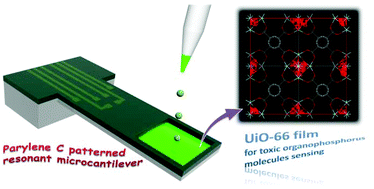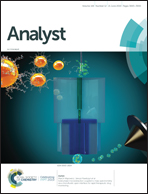In situ construction of metal–organic framework (MOF) UiO-66 film on Parylene-patterned resonant microcantilever for trace organophosphorus molecules detection
Abstract
The detection of organophosphorus (OP) compounds, which are extremely toxic, is a requirement in many application fields such as food security. Mass-type chemical sensors based on ultra-sensitive resonant microcantilevers exhibit high comparative advantages in OP compound detection. However, it is still a big challenge to construct a sensing film in situ from corrosive precursors on resonant cantilevers for batch fabrication. In this work, Parylene-C is patterned and a sample reservoir is formed on the free-end of resonant microcantilever for constructing the sensing material directly. Not only utilized for corrosive precursor loading and in situ sensing material construction, the Parylene-C film can also be used to effectively protect the integrated elements from damage by corrosive substances. For extremely toxic OP molecule detection, a typical metal–organic framework (MOF) of UiO-66 film has been regioselectively constructed in situ on the Parylene-C patterned microcantilevers. A limit of detection (LOD) of 5 ppb for the OP simulant dimethyl methylphosphonate (DMMP) is achieved. The in situ MOF construction method manifests satisfactory consistency for sensor batch fabrication. The DMMP sensing mechanism is identified as the specific host–guest interaction between the UiO-66 and OP molecule.



 Please wait while we load your content...
Please wait while we load your content...